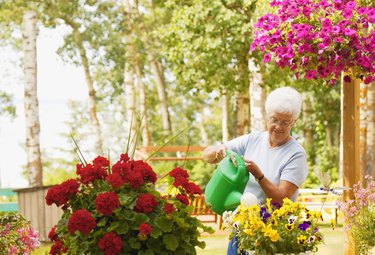
Many people believe that adding rusty water -- or old iron shavings or nails -- to plant pots or garden soil will nourish their plants by adding extra iron to the soil. Yet soil scientists dismiss these ideas without another thought, because iron in the form of rust (iron oxide) is not really available for plant metabolism. But as with many situations, this one is complex. So the actual answer to the rust question is a qualified "maybe."
Why Iron Matters
Video of the Day
Iron is necessary for healthy plant growth, as it is a key component of some enzymes and proteins and also essential for chlorophyll development, nitrogen fixing, plant respiration and metabolism. Iron chlorosis is common in some parts of the country, and is a serious, often-fatal iron deficiency in plants characterized by yellow or white leaves with thin green veins. But iron chlorosis is rarely caused by lack of iron in soil.
Video of the Day
Understanding Iron Availability
Usable iron is abundant in most soils. Where it's chronically unavailable, this is rarely due to lack of iron in the soil but instead because of other factors that limit a plant's ability to metabolize it. High soil pH (very alkaline soil) is a common culprit, a situation worsened by poorly aerated, compacted or waterlogged ground. (Paradoxically, in acidic soils these latter conditions can lead to very high, often toxic plant iron levels.) Iron chlorosis can also be a symptom of overwatering. Too little organic matter -- and sometimes too much -- poses problems too. Heavy use of high-phosphate commercial fertilizers can slow iron absorption, as does applying too much soluble nitrogen. The dynamic balance of iron with other nutrients is also important.
Iron-Healthy Soils
It probably won't hurt your plants to irrigate with rusty water or to add rusted iron to planting pots or garden beds. But it won't help much either, at least not immediately. Iron metabolism depends on soil chemistry at the microscopic level. In healthy soils, the ongoing process of iron chelation, or transforming iron into usable forms, makes it available as plants need it. So supporting overall soil health is usually a better approach for resolving iron deficiency. Ensure adequate iron uptake by solving overwatering and drainage problems, and then cultivate friable, well-drained, nonalkaline soils with adequate levels of organic matter. Build raised beds if all else fails to solve serious drainage issues.
Effective Intervention
If treatment is truly necessary, iron sulfate and chelated iron-rich fertilizers quickly correct iron deficiency in lawns. But these treatments are less successful for vegetables, shrubs and trees. Treating iron chlorosis is expensive and often ineffective without first correcting underlying soil problems. If iron deficiency is a chronic problem for plants trying to thrive in your soil, avoid those that are particularly susceptible to iron chlorosis, including most acid-loving plants.